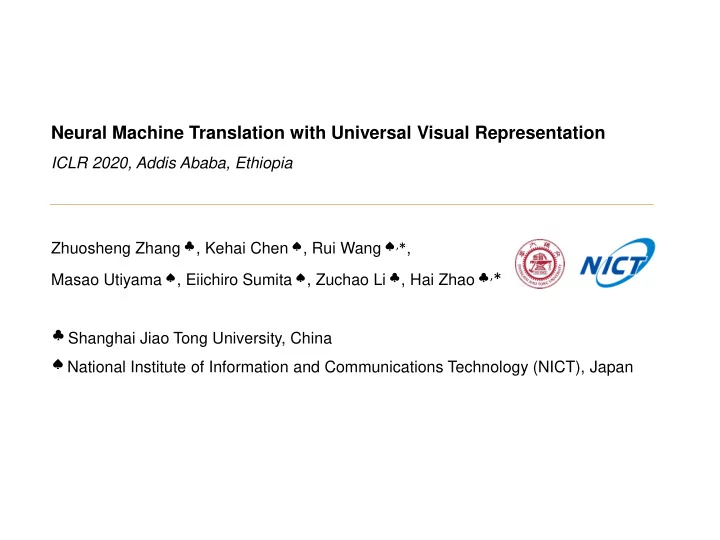

Neural Machine Translation with Universal Visual Representation ICLR 2020, Addis Ababa, Ethiopia Zhuosheng Zhang ♣ , Kehai Chen ♠ , Rui Wang ♠ , * , Masao Utiyama ♠ , Eiichiro Sumita ♠ , Zuchao Li ♣ , Hai Zhao ♣ , * ♣ Shanghai Jiao Tong University, China ♠ National Institute of Information and Communications Technology (NICT), Japan
Overview TL;DR: universal visual representation for neural machine translation (NMT) using retrieved images with similar topics to source sentence, extending image applicability in NMT. Motivation: 2. Limited Diversity: 1. Annotation Difficulty: • • Parallel sentence-image pairs A sentence is paired by only a single image . • • The high cost of annotation Weak in capturing the diversity of visual clues. Solution: • Apply visual representation to text-only NMT and low-resource NMT • Propose a universal visual representation (VR) method 1) relying only on image-monolingual instead of image-bilingual annotations 2) breaking the bottleneck of using visual information in NMT Paper : https://openreview.net/forum?id=Byl8hhNYPS Code : https://github.com/cooelf/UVR-NMT 2
Universal Visual Retrieval • Lookup Table : Transform the existing sentence-image pairs into topic-image lookup table from a small-scale multimodel dataset Multi30K • Image Retrieval : a group of images with similar topic to the source sentence will be retrieved from the topic-image lookup table learned by TF-IDF . 3
NMT With Universal Visual Representation Encoder : Text (Transformer encoder), Image (ResNet) Aggregation : (Single-head) Attention Decoder : Transformer decoder 4
Experiments NMT: WMT’16 EN - RO, WMT’14 EN - DE, WMT’14 EN -DE MMT: Multi30K 5
Ablations of Hyper-parameters • A modest number of pairs would be beneficial. • The degree of dependency for image information varies for each source sentence, indicating the necessity of automatically learning the gating weights. 6
Ablations of Encoders We replace the ResNet50 feature extractor with 1)ResNet101; 2)ResNet152; 3)Caption: that adopts a standard image captioning model (Xu et al., 2015b); 4)Shuffle: shuffle the image features but keep the lookup table; 5)Random Init: randomly initialize the image embedding but keep the lookup table; 6)Random Mapping: randomly retrieve unrelated images. • More effective contextualized representation from the visual clue combination instead of just the single image enhancement for encoding each individual sentence or word. 7
Discussion Why does it work : • the content connection of the sentence and images; • the topic-aware co-occurrence of similar images and sentences. • the sentences with similar meanings would be likely to pair with similar even the same images. Highlights : • Universal: potential for general text-only tasks, e.g., using the images as topic guidance. • Diverse: diverse information entailed in the grouped images after retrieval. 8
Lookup Table 9
Retrieved Images 10
Thanks! Q & A
Recommend
More recommend